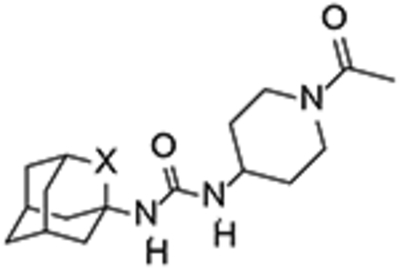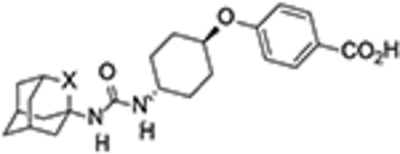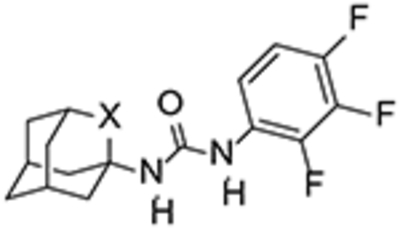Table 1.
Human sEH IC50 and solubility, melting point and permeability values for known adamantane inhibitors AR9281, t-AUCB and 3, and their oxygen analogs 12, 14 and 7.
| Compounds | X | h sEH IC50 (nM)[a] | Solubility (μM)[b] | Melting Point (°C) | Permeability (Caco-2) | |||
|---|---|---|---|---|---|---|---|---|
| Papp (nm/s) | ER[c] | |||||||
| A→B | B→A | |||||||
 |
1, AR9281 (UC1153) | CH2 | 8.0 | 24 | 202–204[d] | 2.2 | 141.2 | 64.5 |
| 12 | O | 29.9 | 59 | 172–173 | 22.4 | 94.5 | 4.3 | |
 |
2, t-AUCB | CH2 | 0.5 | 25 | 250–255[e] | 1.9 | 210.3 | 111 |
| 14 | O | 9.0 | >100 | 255–257 | 1.4 | 75.5 | 55.4 | |
 |
3 | CH2 | 7.7 | 16 | 216–219 | 6.7 | 4.6 | 0.69 |
| 7 | O | 21.3 | 27 | 196–198 | 168 | 151 | 0.9 | |
IC50 values are the average of three replicates. The fluorescent assay as performed here has a standard error between 10 and 20% suggesting that differences of two-fold or greater are significant. Because of the limitations of the assay, it is difficult to distinguish among potencies < 0.5 nM.25
Solubility in a 1% DMSO: 99% PBS buffer solution, see Experimental Section for details.
The efflux ratio was calculated as ER = (Papp B→A) / (Papp A→B). See the Experimental Section for further details.
Taken from reference 27.
Taken from reference 16.
